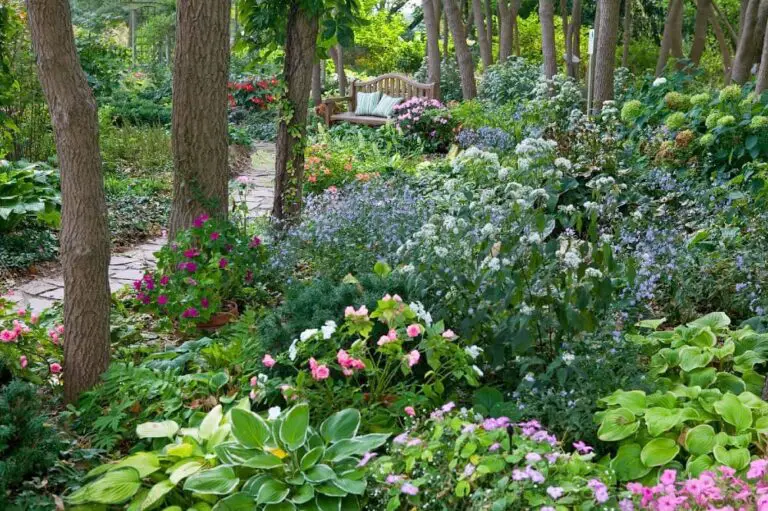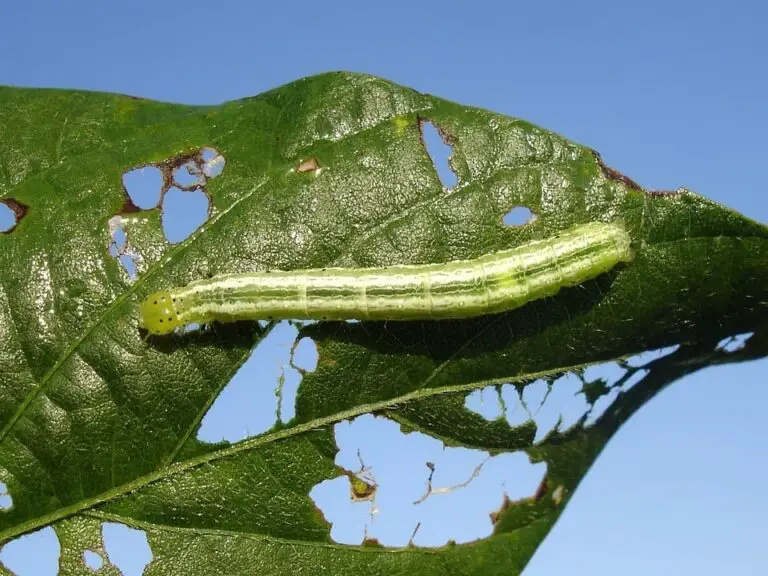22 Types Of Anthuriums With Photos
Anthurium is a diverse and unique species native to the rainforests of Central and South America. With over 20 different types to choose from, it’s no wonder why many people enjoy growing these plants in their homes. However, caring for anthuriums can be quite challenging. In this guide, I’ll provide an overview of the most popular types of anthuriums that you can grow at home.
One of the unique features of anthuriums is their wide range of species, each with its own distinct characteristics and growing conditions. Some popular varieties include Anthurium Andreanum, also known as the Flamingo Lily or painter’s palette, which is known for its bright pink flowers. Another popular variety is the Tulip Anthurium, which has large, tulip-shaped flowers in shades of red and orange.
Other notable species include the Velvet Cardboard Anthurium, which features soft, velvety leaves, and the Ace of Spades Anthurium, which has striking black and white markings. For those looking for a more exotic look, the Bird’s Nest Anthurium has long, curved leaves that resemble a bird’s nest. Each species has its own set of growing requirements, from light to water to humidity. By understanding these needs, you can create the perfect environment for your anthurium to thrive.
Anthurium Facts
Anthurium, the largest genus within the Araceae family, comprises approximately one thousand species, with a remarkable range of epiphytic and terrestrial plants. These unique organisms thrive in crevices of rocks or shallow limestone soil, showcasing their adaptability to diverse environments. Interestingly, all Anthurium species are toxic, though symptoms typically subside over time. As such, it is crucial to maintain a safe distance between these plants and children and pets.
The genus name Anthurium originates from the Greek words ‘anthos,’ meaning flower, and ‘oura,’ signifying tail. This captivating tropical plant was first introduced by Austrian botanist Heinrich Wilhelm Schott in 1829. Over time, the genus has been refined through further classification. Despite their toxicity, Anthuriums have earned a reputation for being exotic and rare, with species offering something for every enthusiast’s taste.
The flamingo flower moniker is well-deserved due to the striking heart-shaped blooms that frequently display vibrant, fiery hues. The plant’s stunning leaves, typically shaped like hearts or ovals, add to its allure, making Anthurium an attractive choice for collectors of rare and unusual plants.
Anthurium Symbolism
According to ancient Chinese wisdom, Anthurium plays a crucial role in achieving harmony in one’s home, as depicted by Feng Shui. This tropical plant is not only believed to symbolize love and family happiness but also possesses the power to calm and purify an individual of negative thoughts. As a reflection of one’s mental state, the Anthurium’s health is often seen as a indicator of personal growth, with wilting suggesting the need for self-improvement.
With its profound effects on those around it, let us explore some of the most common varieties of this captivating plant.
Anthurium Types
Anthurium Andreanum (Flamingo Lily, painter’s palette)

Flamingo Lily stands out as a showstopper within the Anthurium family, captivating enthusiasts of flowering plants with its unique charm. At the heart of this plant’s allure is its striking flower, situated atop a 2-inch long stem and nestled beneath a dramatic, heart-shaped leaf that spans over 6 inches in length. The true pièce de résistance, however, lies in the vibrant, bright red hues of the incredible flower blades, which evoke the fiery plumage of the majestic Flamingo birds.
With a flowering period that can stretch up to five to six months, this remarkable species is sure to delight. Interestingly, Anthurium Andreanum was first discovered in Colombia, its exotic origins only adding to its allure.
Anthurium Amnicola (Tulip Anthuriums)
The Tulip Anthurium’s distinctive lilac flowers are a notable feature, boasting tulip-shaped blooms with deep purple spadixes and lilac petals. Typically, Anthurium species produce heart-shaped leaves, which provide a striking contrast to the subtle dark green elliptic leaves of this particular variety.
Native to South America, specifically the tropical islands of Panama, Tulip Anthuriums thrive in wild rainforests alongside streams, often growing on large rocks.
As a result, they have earned the admiration of houseplant collectors for their understated elegance.
Anthurium Bonplandii

Anthurium Bonplandii is a species with several subspecies to its name. One of the most notable is the Guyana subspecies, which exhibits a unique growth pattern resembling a bird’s nest. This particular subspecies originates from the Venezuelan mountains and can also be found in northern Brazil and Suriname. What sets Anthurium Bonplandii apart is its striking foliage, characterized by thick and large leaves with a leathery texture.
The subspecies Bonplandii typically features elliptical leaves, whereas the Guyana variety displays lanceolate or oblong leaves that taper towards the apex, with some specimens having wider middles.
Anthurium Clarinervium (Velvet Cardboard Anthurium)

The Velvet Cardboard Anthurium’s unique name originates from its striking heart-shaped leaves, which boast a velvety texture. Among all Anthurium species, its dark green foliage stands out for its prominent white veins. Some enthusiasts refer to it as the White Venous Anthurium due to this distinctive feature. Native to Mexico’s lush rainforests, the Anthurium Clarinervium is a breathtaking tropical species that thrives in these humid environments.
Anthurium Crystallinum (Anthurium Ace of Spades)

Anthurium Crystallium, also known as the ‘Ace of Spades’, is a unique species renowned for its stunning foliage. Characterized by leaves that can reach an impressive 19 inches in length, these dark green, velvety leaves boast striking yellow-white veins. The subtle beauty of this species lies not only in its elaborate leaf structure but also in its ability to produce small, inconspicuous flowers that are a light green to whitish hue.
One of the most notable features of Anthurium Crystallium is its perpetual flowering habit, making it an ideal choice for year-round decoration and adding a touch of elegance to any room.
Anthurium Clavigerum

In the realm of epiphytes, Anthurium Clavigerum stands out as one of the most impressive species in Central America. Its remarkable height is a notable feature, with mature plants boasting inflorescences that can stretch up to 3 feet tall. One of the key identifying characteristics of this species is its striking combination of ornamental leaves and pendant flowers, which are rarely mistaken for those of any other Anthurium species in the region.
As these plants mature, their leaves take on a unique curling and dividing pattern. Spanning from Nicaragua to Guyana, Brazil, and Bolivia, A. clavigerum is widely distributed across Central America.
Anthurium Coriaceum

The Paddle Leaf, a standout among its peers, boasts an impressive height of up to 3 feet. Its remarkable foliage features rich, velvety leaves with an erect and paddled shape. A distinctive middle vein runs along the back of each leaf, setting it apart from other species. The flowers, too, are a striking sight, with their green hue and brown spade-like structure. Native to the lush rainforests of Brazil, Anthurium Coriaceum thrives in humid environments.
Anthurium Forgetii

One of the most striking features of Anthurium Forgetii is its unique flowering pattern. During the blooming period, the spike becomes adorned with tiny purple berries that contain seeds for reproduction. These berries are a distinguishing characteristic of this species, setting it apart from others. The foliage also plays a key role in its distinctiveness, featuring dark green leaves with white veins that create an attractive contrast.
Unlike other Anthuriums, Forgetii’s leaves are relatively small and oval-shaped, adding to its singular appearance. Interestingly, this unique species is endemic to Colombia, making it a rare find outside of its native habitat.
Anthurium Faustomirandae (Faustino’s Giant)

Anthurium Faustomirandae, often dubbed the largest Anthurium in the world, boasts an impressive size that sets it apart from its peers. While Anthurium Regale may be the largest species within the genus, Faustino’s Giant takes the crown as the largest native Mexican species. Interestingly, this stunning plant was previously known as Anthurium Whitelockii before its official renaming. What truly sets Faustomirandae apart is its extraordinary foliage.
The magnificent heart-shaped leaves can grow an astonishing 9 feet long, featuring a glazed texture that’s both thick and durable. The sturdy stalks supporting the vibrant green flowers with their chestnut-colored seedlings add to the plant’s overall grandeur. As a rare terrestrial species, Anthurium Faustomirandae is surprisingly easy to cultivate and makes for an exceptional choice as a landscape tropical plant.
Anthurium Hookeri (Bird’s Nest Anthurium)
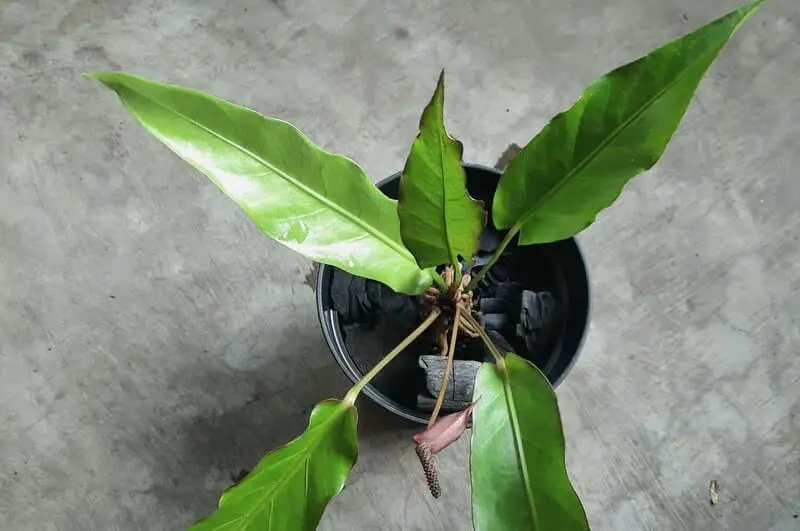
In the realm of exotic beauty, Hookeri stands out as a true marvel. Its striking features include elongated, six-foot-long, and hanging leaves that exude the essence of the jungle’s lush foliage. Also known as Bird’s Nest Anthurium, this species is characterized by its unique rosette-like shape. The bright green leaves, adorned with shorter interstices rather than protruding veins, take on a distinctive form reminiscent of long giant spoons.
While it may produce flowers and tiny white berries, the rich foliage remains the main attraction. To thrive, Hookeri requires a balanced distribution of energy to focus on the growth and development of its bushy leaves.
Anthurium Luxurians
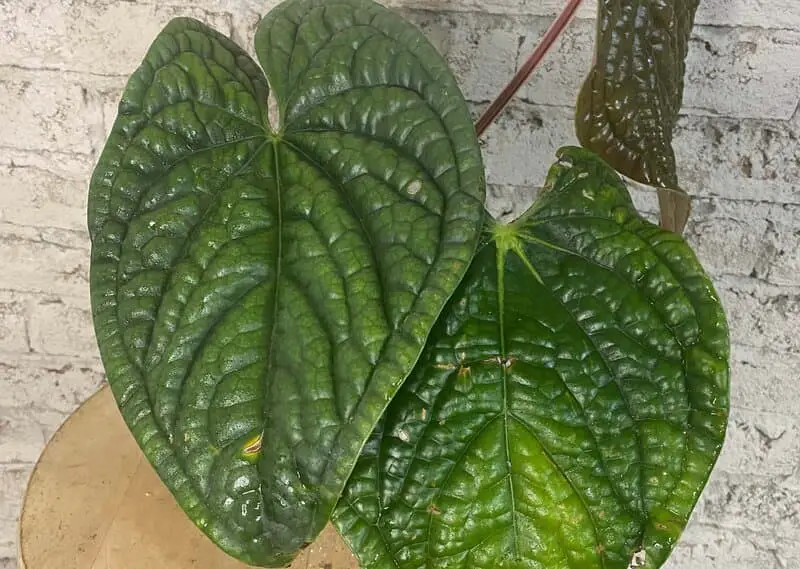
The luxurious Anthurium Luxurians, formerly known as Anthurium Splendidum, boasts striking features that evoke the allure of a black diamond. Its dense, leathery leaves and short stems create a stunning display, with the leaf shape resembling the facets of a finely cut gemstone. Measuring up to 11 inches in height, these stems support leaves that can grow remarkably wide – between 15-23 inches.
A notable characteristic of young plants is their pale coloring, which gradually darkens as they mature. Initially, they transition through shades of pink, brown, and blue before settling into a lush green hue. As the leaves reach full maturity, they transform into a deep, rich color. Native to Colombia’s lowland tropics, this beautiful species thrives in its natural habitat.
Anthurium Magnificum

Anthurium magnificum stands out among its peers in the Anthurium genus due to its extraordinary foliage. The velvety texture of its oval-shaped leaves, featuring prominent veins, is a defining characteristic of this rare species. Reaching an average size of 2 to 3 feet, it’s a statement piece that commands attention. But what truly sets it apart is its year-round blooming habit, yielding vibrant red flowers that provide a stunning contrast.
With proper care, Anthurium magnificum has the power to transport your office into a lush tropical haven.
Anthurium Pachyneurium (Big Red Bird Anthurium)

The Anthurium family is characterized by its unique lanceolate leaves, distinguished by wavy edges and rolled inwards on both sides from the rim. In contrast to other members of the same family, which often exhibit spiraling leaf patterns that twist in one direction, Big Red Bird boasts an extraordinary feature – its leaves change color depending on light or temperature. When exposed to bright light, the leaves turn a vibrant red.
Additionally, this species stands out due to the absence of prominent veins, a trait not commonly found among other Anthurium varieties. The birds-nest anthuriums display a rosette growth pattern and can grow up to 6 feet tall, with individual leaves reaching lengths of 3 feet.
Anthurium Pedatoradiatum

Anthurium Fingers stands out for its extraordinary features, particularly its leaves that resemble human fingers due to their slender shape and deep lobes. Measuring up to 3 feet in height, these leaves are accompanied by stems ranging from 13 inches to 37 inches in length. This unique arrangement sets Anthurium Fingers apart from other species within the genus Anthurium, which is often classified as terrestrial.
Native to southern Mexico, this species can thrive in temperate climates when grown indoors as a houseplant. With the right conditions, it’s possible to cultivate a striking and conversation-starting addition to your home or garden.
Anthurium Pendulifolium

With lengths reaching up to 4 feet, the pendulous and elongated leaves of Anthurium Pendulifolium are truly remarkable. While the upper surface of these leaves may be uniformly colored, some specimens exhibit a subtle bi-colored effect. As such, a hanging basket provides an ideal environment for this species to thrive. In Ecuador, indigenous communities have long utilized A. Pendulifolium in traditional healing practices.
According to local lore, boiling the leaves can help alleviate bone aches and rheumatism symptoms.
Anthurium Radicans

In the lush rainforests of southeastern Brazil and parts of Ecuador, you’ll find the extraordinary Anthurium Radicans. This tropical epiphyte thrives on tree trunks, its unique characteristics setting it apart from other plants. One of its most striking features is the spacious, heart-shaped leaves that are a vibrant green color with a distinct fibrous texture. When the plant blooms, it produces exotic, deep pink or maroon flowers that add to its allure.
The distinctive shape of its leaves has led to this plant being revered as a symbol of hospitality, making it a popular choice for both indoor and outdoor gardens.
Anthurium Scandens (Pearl Laceleaf)

The remarkable ‘pearly white berry’ producing species has its name aptly attributed to the clusters of lustrous, white fruit that dangle from stems. Its origins can be traced back to the lush rainforests of Brazil and southern Mexico. The leaves of this stunning epiphyte are equally impressive, boasting an oval shape, matte green hue, and reaching lengths of up to 5 inches.
In terms of growth habits, it’s worth noting that this species forms aerial roots, allowing it to thrive without soil substrates. If you’re looking to cultivate this specimen in your own home, it can be happily grown on the surface of other plants, provided a humid environment and regular watering are maintained.
Anthurium Scherzerianum (Flamingo flower)

Anthurium Scherzianum, the initial variety of Flamingo Flower, has earned a special place in the hearts of Anthurium enthusiasts. Its low maintenance requirements make it a prized possession among plant lovers. The species’ unique foliage is characterized by leaves that emerge from the center at varying angles, measuring up to 7 inches in length. These lanceolate leaves boast a light green hue, a glossy texture, and are attached to sturdy stems.
In contrast, the flowers of Anthurium Scherzianum are erect and exhibit a vibrant array of colors, including red, white, pink, and freckled patterns. This ornamental houseplant is often grown for its showy inflorescence, which adds a pop of color to any room.
Anthurium Veitchii (King Anthurium)
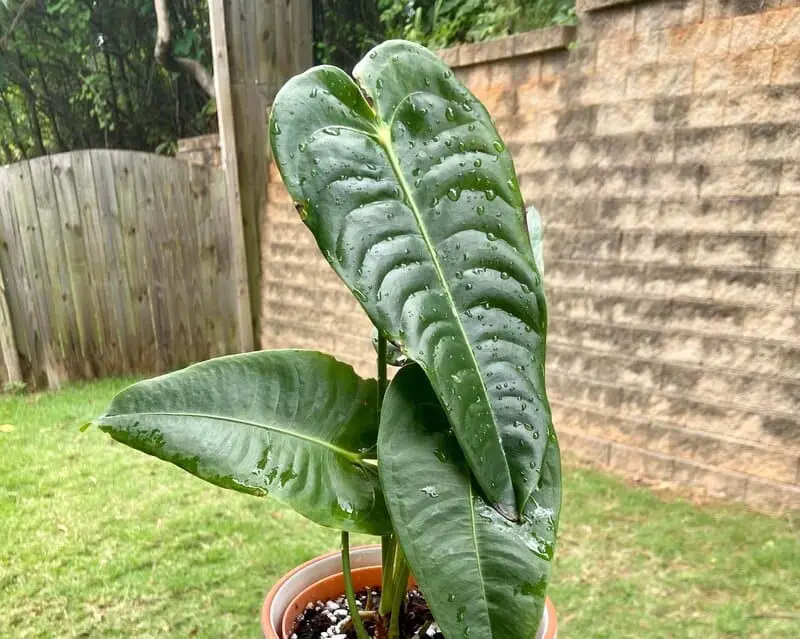
The majestic Anthurium Veitchii boasts extraordinary features, including its massive, elongated heart-shaped leaves that are a vibrant green color. To achieve lengths of four to five feet, specific growing conditions are necessary. It’s no wonder this species is often referred to as the ‘king’ of the family.
Native to Colombia, King Anthurium is an epiphytic species that thrives in more temperate climates, typically cultivated in greenhouses or as a houseplant.
When grown outdoors, it can create a stunning landscape view, making it a popular choice for those seeking a unique addition to their garden.
Anthurium Vittarifolium

Among the various species of Anthurium, Vittarifolium stands out for its extraordinary beauty. When it blooms, its unique charm is revealed as pink berries form an intricate pattern between the vibrant greenish-yellow leaves. Not only are these berries a treat to behold, but they also contain seeds that can be used for further planting.
In contrast to many other Anthurium species, Vittarifolium’s leaves may exhibit hints of lime color, adding to their lush and elongated appearance which can reach up to 6.5 feet in length. Native to the humid forests of South America, this plant has adapted well to being cultivated in a home environment, thriving with regular watering and proper placement. As such, it has the potential to add a pop of vibrancy to any room.
Anthurium Warocqueanum (Queen Anthurium)
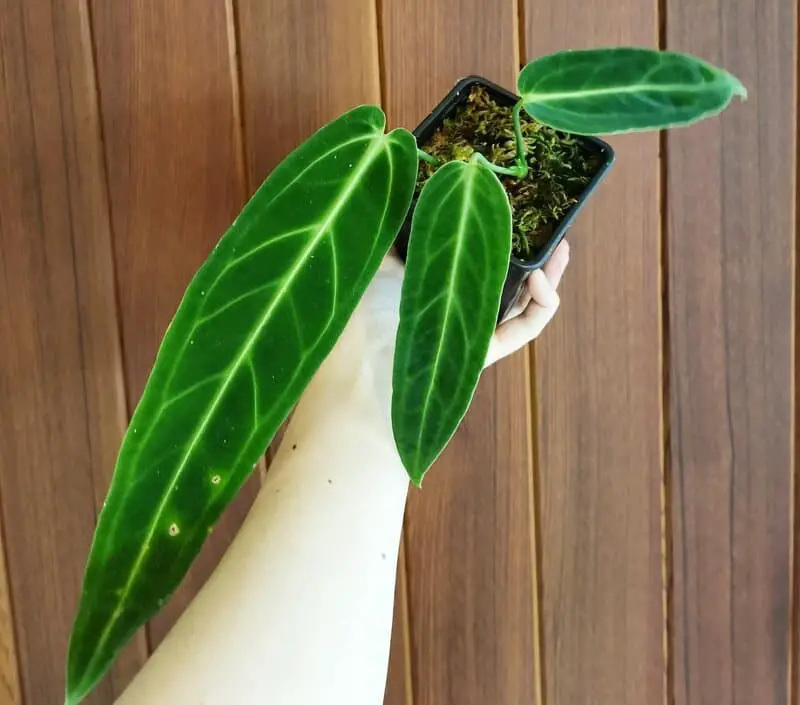
Queen Anthurium stands out as a stunning addition to any botanical collection. Its striking foliage can reach up to six feet in mature plants, boasting long, velvety leaves that are a sight to behold. The leaves themselves showcase a deep green hue with silver veins that become increasingly prominent as they grow. While some specimens may exhibit lighter tones, the sheer size of these leathery leaves is undoubtedly the Queen Anthurium’s crowning glory.
Native to the tropical regions of western and central Colombia, this perennial plant is an ideal choice for those who appreciate elegant, statuesque additions to their indoor or outdoor spaces.
Anthurium Watermaliense (Black Anthurium)

Anthurium’s most extraordinary ornamental variant is undoubtedly the black variety. Its striking dark-colored blooms are highly prized for their one-of-a-kind uniqueness. The plant’s vibrant green leaves and glossy, leathery cover further captivate the eye. As a bud forms, it initially lacks the same level of darkness, but gradually takes on its signature deep hue over time. Thanks to the tireless efforts of growers and botanists, we can now marvel at the Anthurium Black Queen.
This artificially cultivated variety may boast an impressive burgundy-black bloom, earning it the nickname ‘Black Prince’ due to its masculine appearance.
Anthurium Care
Anthurium care doesn’t stop at providing the right conditions – understanding how to nurture this beautiful plant is just as important. For those new to growing Anthurium, our comprehensive guide on How to Grow Anthurium: All You Need To Know is a must-read. Whether you’re an experienced horticulturist or just starting out, this article will walk you through the ins and outs of Anthurium cultivation, from propagation to maintenance.
Soil
When it comes to providing an ideal environment for Anthurium, it’s essential to focus on drainage and moisture retention. To achieve this, start by adding a layer of small rocks or gravel at the bottom of the pot. This will prevent waterlogged soil from developing and ensure that excess moisture can escape. For the remaining substrate, consider a mix of perlite, peat moss, and charcoal, all in equal proportions.
This blend offers excellent drainage properties while still retaining sufficient moisture to support healthy plant growth.
Fertilizer
When cultivating Anthurium, it’s essential to avoid fertilizers that contain carbonates, as they can be detrimental to the plant’s health. To encourage lush growth and abundant blooms, provide regular feedings during the vegetation period, spanning from April to September, with two applications per month. For optimal results, opt for organic fertilizers specifically formulated for flowering plants.
With proper care and attention, Anthuriums can thrive and continue to produce stunning flowers and foliage for many years.
Sun & Light
When it comes to providing the perfect environment for Anthurium, indirect light or partial shade is key. Direct sunlight should be avoided at all costs, as it can cause significant damage to the plant’s delicate leaves. Instead, look for a location where the light is diffused, such as under a skylight or near a shaded window. This will help to regulate the amount of light your plant receives, ensuring it stays healthy and thriving.
To further adjust the lighting conditions, consider using transparent curtains on your windows to filter out intense rays and create a more controlled environment for your Anthurium. By doing so, you can tailor the light to suit the changing weather conditions, giving your plant the best possible start in life.
Water
To keep your Anthurium thriving, establish a consistent watering schedule. Aim to provide ample moisture in the morning hours, allowing the soil to dry slightly before the next hydration session. When it comes to the type of water used, stagnant or boiled H2O is ideal when the soil is parched. In winter, you can expect to water every 10-12 days, while summer watering should occur approximately every three days.
Additionally, a weekly gentle rinse using a damp cloth or shower can work wonders for your plant’s overall appearance. Be mindful of yellow and dry leaves on your Anthurium, as they often result from an imbalance in the watering routine.
Humidity & Temperature
To ensure optimal growth for your Anthurium, maintain a consistent temperature range of 60-86°F. Avoid sudden drops in temperature, as this can cause plant decay. During the winter months, ensure the temperature remains above 59°F to prevent damage. Should you notice leaf wilting, relocate the plant immediately to resolve any draft issues. By providing your Anthurium with suitable living conditions, including humidity levels above 50 percent, you’ll be emulating its natural environment.
To maintain optimal humidity, occasionally spray the leaves with boiled or stagnant water. When the plant is not in a stagnation period, refrain from wetting the leaves. In the summer, increase spraying frequency to several times a day, and in winter, reduce it to once daily when the air is particularly dry.
Repotting
When it comes to transplanting orchids, timing is everything. For young plants, March or April is the ideal time to do so, as this allows them to establish themselves before the growing season begins. In contrast, older plants typically require repotting every three years, and should be transferred into a slightly larger pot with fresh substrate. It’s essential that the new pot has good drainage, as orchid roots tend to thrive in compact conditions.
Before transplanting, it’s also crucial to clean the roots of any old soil and provide a layer of fresh drainage material to prevent waterlogged conditions.
Pruning
To keep this species thriving, occasional pruning is essential to maintain its health and remove any infected or damaged leaves. The frequency of pruning depends more on the overall condition of your plant than the time of year.
Start by inspecting your plant for any areas that appear unhealthy, such as brown and crunchy leaves that are ready for removal. Pay particular attention to any withered or dead foliage, which should be cut off at the base of the stem to prevent the spread of disease.
If your plant appears a bit leggy, consider removing older leaves to give the younger growth room to receive adequate nutrients. By doing so, you’ll help promote healthy growth and encourage your plant to focus its energy on developing strong, vibrant new leaves.
Propagation
Anthurium propagation involves two primary methods: seed starting in the spring and division of young plants growing at the base of a mature plant. For optimal results, this process is best conducted during January or February when temperatures are around 70°F. To propagate through seeds, use the same soil mixture as the adult plant’s potting medium. Initially, keep the pots in partial shade until the seedlings emerge, then transfer them to fresh air.
Once they’ve sprouted, carefully excavate young plants with their roots and transplant them into a specialized container. Division of older plants occurs after the blooming phase. When separating the sides of an established plant, ensure each section has a well-developed root system and leaves. These divided plants should be planted in shallow, wide pots with a drainage layer at the bottom and placed in a warm room where temperatures exceed 68°F.
Young plants require regular watering, preferably before noon, to promote healthy growth. Feeding them will also encourage blooming within the same year.
Pests
Anthurium plants are susceptible to a range of pests, including aphids, mites, and thrips. While these plants are generally resistant to infestations, they can still be affected by lice, which can cause significant damage if left unchecked. One common sign of an Anthurium under attack is the presence of white woolly deposits on the leaves and leaf stalks. To combat this issue, you can use insecticides or opt for a mechanical approach involving cotton wool soaked in methyl alcohol.
Simply wipe down the affected areas gently, repeating the process as needed until the problem is resolved.
Diseases
Root rot and leaf mycosis are typically triggered by fungal pathogens that target plants. If you notice brown spots developing on your plant’s leaves, a systemic fungicide application can help combat the issue. However, it’s essential to identify the root cause of the problem, as these diseases often manifest in distinct ways. Root rot, for instance, is characterized by stunted growth, discolored leaves, and wilting foliage, with the affected roots turning black.
The first signs of infection may not be immediately apparent, but they can become noticeable due to the onset of cooler temperatures and increased moisture levels during autumn and winter. Leaf spot disease, on the other hand, thrives in environments with high humidity and excessive soil moisture. In such cases, large, irregularly shaped brown spots with yellowish rims begin to appear on Anthurium leaves.
To prevent further damage, consider using insecticides or fungicides specifically designed for these types of issues.
Frequently Asked Questions
How many types of Anthurium are there?
With over 1000 species spread across the genus Anthurium, belonging to the Araceae family, this group is known for its incredible diversity. While many of these species are grown indoors as ornamental plants, it’s the hybrids that truly showcase their unique shapes and colors. Among the most popular varieties are A. scherzerianum, A. andreanum, and A. crystallinum, which have become staples in many indoor gardens.
Are there miniature anthuriums?
While miniature Anthuriums share similarities with other varieties, they have unique requirements that ensure optimal growth. For instance, these plants thrive in shaded environments and require consistent watering to stay healthy. In terms of physical characteristics, the spathe can reach up to 3 inches in length, while the stem typically grows between 3-7 inches long.
One of the most striking features of miniature Anthuriums is their vibrant color palette, which includes a range of hues such as red, white, and lavender. The spathe itself often boasts a contrasting color scheme, featuring a red or yellow spadix that adds an extra layer of visual interest.
Do Anthuriums like bathrooms?
When selecting an ideal location for your Anthurium, consider placing it in a bathroom or kitchen, as these spaces offer the highest levels of humidity that closely mimic its native environment. To maintain optimal conditions, avoid positioning the plant near radiators, as this can disrupt the natural moisture balance and potentially compromise the plant’s health.
Conclusion
To showcase the beauty of Anthurium, it’s essential to recreate their natural environment. Unlike other tropical plants, Anthurium thrives under consistent conditions, making it crucial not to alter these once established settings. These stunning plants boast striking flowers and vibrant, dark green leaves that exude a sense of longevity and sophistication. As a symbol of hospitality, Anthurium adds an air of exoticism to any space, conveying the owner’s welcoming nature.
When you encounter an Anthurium in someone’s home or office, it serves as a testament to their commitment to providing a warm and inviting atmosphere.
Related Posts
When it comes to indoor gardening, finding the right balance between care and neglect can be a challenge. To help you achieve thriving houseplants, here are four essential tips: First, ensure your plants receive sufficient light by placing them near windows or using grow lights. Next, maintain a consistent watering schedule, as overwatering is a common mistake that can lead to root rot. Thirdly, fertilize your plants regularly to promote healthy growth and development.
Finally, monitor for pests like spider mites and mealybugs, which can quickly spread and damage your plants. By following these simple yet effective tips, you’ll be well on your way to becoming an indoor gardening pro.


